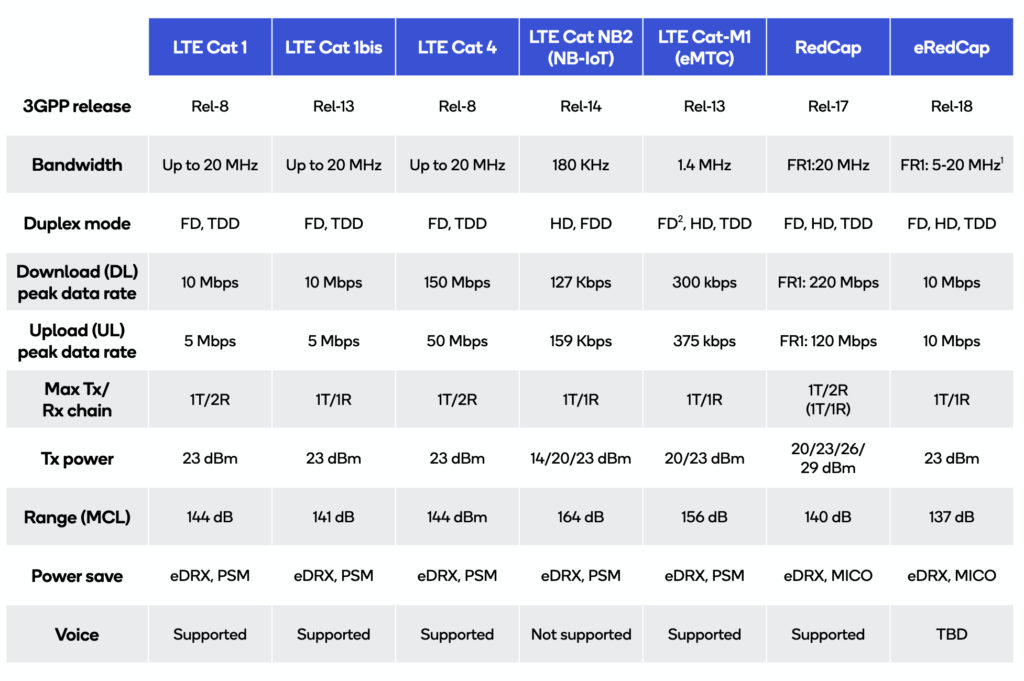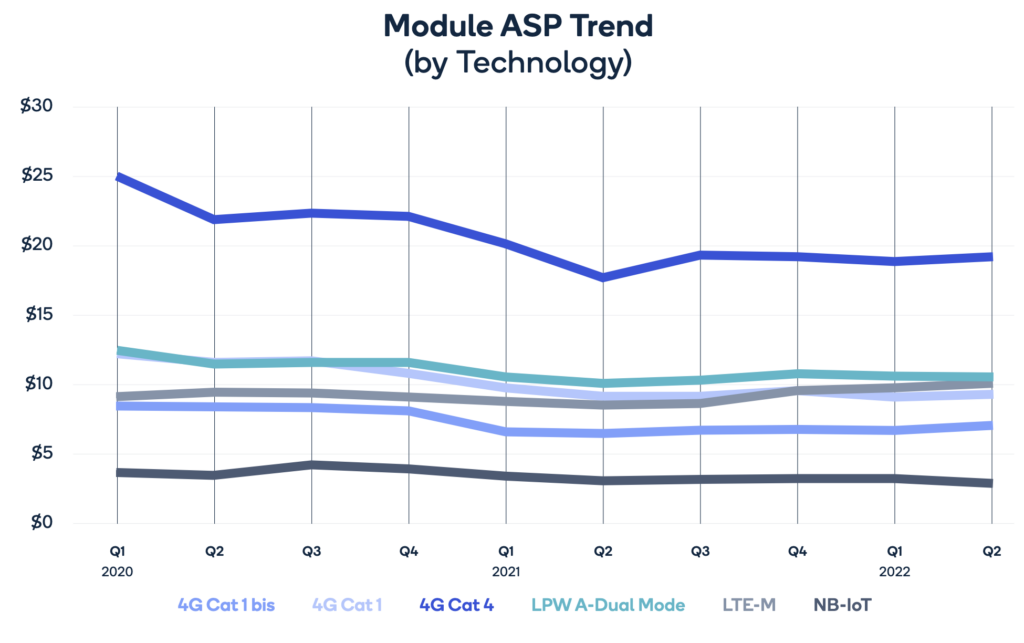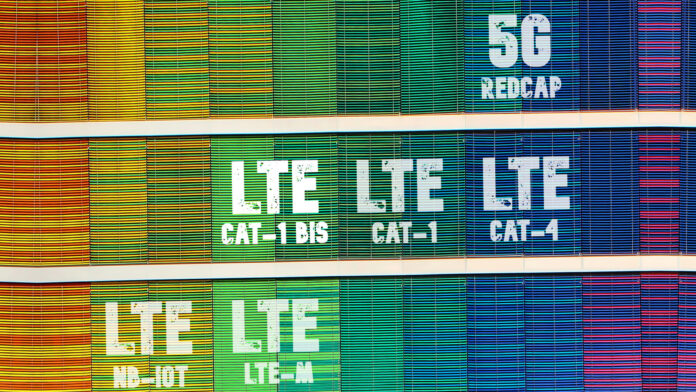Qualcomm has a white paper, actually from last year, about the benefits of LTE Cat 1bis, which makes it hard to see much of a future in NB-IoT and LTE-M for low-powered IoT applications. Indeed, the comparison exercise suggests Qualcomm wants IoT providers to take advantage of the straighter economies-of-scale afforded by purer LTE-based technologies, and their clearer migration to incoming 5G-based technologies. The message is, almost, to forget about these bastard LTE spinoffs, designated for minimalist IoT almost a decade ago in Release 13 of the LTE standard.
It doesn’t actually say that, of course; but the takeaway, after reading through, is that all the heavy lifting at network and device-level in order to make NB-IoT and LTE-M work quickly erodes the acute marginal gains they deliver for a niche set of parochial low-power IoT use cases. In the end, LTE Cat 1 and LTE Cat 4 modules work globally by default, and are well-priced (pound for pound) and easily available (case by case) – to the point they are a viable alternative, also, for low-power wide-area network (LPWAN) IoT sensing, even if they are generally over-specified.
More than this, LTE Cat 1bis, specified in the same 3GPP release as NB-IoT and LTE-M, and rapidly coming of age in IoT circles, does away with the second LTE receiver (Rx) antenna, to “make it easier and cheaper to build devices in smaller form factors”, as Qualcomm writes. The sense is that mainstream LTE-based Cat 1bis closes the gap further from a cost point of view to NB-IoT and LTE-M, as the original IoT-optimised LTE twin-set, and extends it in terms of global compatibility. Plus, it has a simpler 5G future, as a launch/landing pad for eRedCap in Release 18.
Anyway, here is a summary of the Qualcomm paper, written ostensibly to promote its own 216 LTE IoT modem, but full of good points. Its analysis says LTE Cat 1bis is comparable or better on almost every score than NB-IoT/LTE-M – easier implementation, better deployment, clearer evolution. Really, the only comparisons are cost and coverage – and the former is comparable, anyway, it says, and the latter is only for static meter-style apps. The original document is available here, and features additional commentary. All the edited quotes below are from Qualcomm.

1 | Deployment
“One of the impediments [with] NB-IoT and LTE-M is [they] require operators to upgrade software… [which] comes with extra capital [and…] operational expenditure… In addition, for LTE-M deployment, operators need to earmark six resource blocks; in many cases, that can constitute as much as 10 percent of the available bandwidth in lower parts of the spectrum. [Without sufficient] load, the capacity dedicated to LTE-M… will be underutilized… There are ways to minimize the losses… [but they] require additional software licenses and network upgrades.
“In contrast, Cat 1bis devices operate on the regular LTE network… Operators do not need to [upgrade…] their RAN or core network. The eNB functions – such as admission control, congestion control, mobility management and scheduling – are common between Cat 1bis and regular Cat 1. The LTE network treats a Cat 1bis device in the same way as a Cat 1 device, but with one Rx antenna. No dedicated bandwidth needs to be allocated for Cat 1bis devices; they coexist with regular LTE Cat 1, Cat 4 and smartphones on the same network and spectrum.”
2 | Roaming
“Global [LTE-M and NB-IoT] data connectivity… is a distant dream. Not all operators deploy [them, and coverage is] fragmented… NB-IoT is deployed by 110 operators [in] 60 countries; LTE-M is commercialized by 60 operators in 34 countries… [They] are available in most parts of Europe, North America and Australia, plus parts of Asia. [But] the state of international [LPWAN] roaming is quite different… It is difficult to [find an LTE-M] device that works everywhere…. NB-IoT [roaming requires] a multi-mode device…
“[But] operators today provide LTE data connectivity in nearly every country through an extensive network of roaming relationships, with local breakout options for IP data. IoT LTE Cat 1bis devices that run on the same networks as cell phones benefit from the roaming agreements set up for cell phones. Thus, they can get ubiquitous data connectivity from a single service provider – just as consumer devices do.”
3 | Power
“Meters and trackers… use eDRX and PSM for longer sleep cycles. Commonly used in NB-IoT and LTE-M, [eDRX and PSM] also apply to Cat 1bis… [meaning] Cat 1bis [devices] can enjoy the same extended sleep cycle. Some tracking [cases] allow the device to operate in power-down mode, [where it] wakes up periodically to report data… [and] is unreachable [otherwise]. Similar to LTE-M and NB-IoT, Cat 1bis devices have only one receive RF chain – [meaning] lower cost, some savings in power consumption, and design flexibility
“Another important metric… is ON time: the time a device must be in active mode to complete a data transaction. [This] leads into a discussion of data rates. The peak uplink data rates with [NB-IoT and LTE-M] are 160 Kbps and 375 Kbps in half-duplex mode [but] far lower [in the field] – about 100 Kbps, [down to] tens of Kbps… To upload or receive 500 bytes of data on NB-IoT and LTE-M, device ON time is 400 ms and 40 ms respectively; in contrast, a Cat 1bis device can complete the same… in 8 ms (throughput = 500 Kbps)…
“It is also worth noting that device power consumption is increasingly dominated by tasks unrelated to the cellular modem, such as tracking location and processing sensor data. Even then, power consumption of LTE Cat 1bis modems is now on par with or better than that of LTE-M modems.”
4 | Bandwidth
“The inability to perform firmware over-the-air (FOTA) updates over NB-IoT and sometimes over LTE-M [is a concern]. Sending… a FOTA image [of] a few megabytes takes a long time at LPWAN data rates…. [Even limited] Delta FOTA [updates] reduce ON time [and] require… the delta FOTA framework… IoT devices will [increasingly] send and receive more data, but LPWAN data rates may not suffice… For example, smart energy meters… can (and will) monitor the actual load on the grid, changes in consumption patterns, and fluctuations in metrics like voltage.
“They will then feed the parameters to the utility cloud for quick remedial response from the grid. Those innovations will require higher data rates. The need is particularly acute in asset tracking… Non-ubiquitous [NB-IoT/LTE-M] coverage results in a significant power consumption penalty… compared to Cat 1bis devices… A tracker [on a shipping container] may have to perform PLMN search and registration in several countries [which] takes longer when coverage is not ubiquitous, often requiring additional scanning… The result is sub-optimal power consumption.”
5 | Coverage
“The most vital benefit of LTE-M and NB technology is… coverage. Both use Layer-1 packet repetition… to provide extended coverage compared to traditional LTE. In theory, LTE-M offers a 12 dB extra link margin over LTE, and NB-IoT offers a 20 dB margin. That extended RF coverage comes at the cost of reduced spectral efficiency (reduced data rates) because operators have to allocate more resources for packet repetition and increased latency.
“Due to the reduced number of antennas, LTE Cat 1bis carries an additional 2.5 to 3 dB of penalty compared to traditional LTE Cat 1. Extended coverage is suitable for devices in challenging RF environments such as basements, elevators and deep indoor locations. The extended link margin is not usually indicated for mobile devices like asset trackers, or for devices like parking meters or energy meters that act as a hub to aggregate data from surrounding meters.”
6 | Positioning
“In general, cloud-based positioning techniques rely on user equipment to detect nearby LTE cells. Accuracy tends to improve as a function of the number of cells. As channel bandwidth increases, correlation gain also increases, allowing the device to detect synchronization channels and decode system information from more LTE cells. The envelope supported by Cat 1bis is 20 MHz, compared to… 1.4 MHz in LTE-M. Even if operators deploy 5 MHz or 10 MHz of channel bandwidth, the chances of detecting LTE cells for positioning are higher than in LTE-M.
“That is another reason LTE Cat 1bis is more suitable for a tracker use case.”
7 | Cost

“Similar to [LTE-M and NB-IoT] modules, Cat 1bis modules and devices have a single antenna and a single receive RF chain, in contrast to the two antennae needed for Cat 1 devices. LTE-M and NB-IoT offer a small cost advantage: the RF front end needs no surface acoustic wave filter due to the half-duplex nature of communication. [But] the cost structure of Cat 1bis is comparable…. In 2020, the ASPs of Cat 1bis and LTE-M/NB-IoT modules were [around] $10; since then, the price of Cat 1bis modules has fallen – tied to sharp increases in Cat 1bis sales in Asia.”
8 | Evolution
“3GPP [has] defined an option [to allow] upgraded LTE (eLTE) devices to connect to a 5G core network over upgraded eLTE NB (eNB). Allowing an LTE Cat 1bis device to register with 5G core will… ensure service continuity… in case operators phase out 4G/LTE core networks. LTE Cat 1bis devices can also connect to a combined evolved packet core 5G network… [and] can frequency-share spectrum with 5G NR devices using dynamic spread spectrum (DSS). That will ensure continued service for Cat 1bis devices when operators re-farm LTE spectrum.
“Release 18 standards [includes] enhanced 5G NR RedCap (eRedCap)… [which] is designed specifically for resource-constrained IoT devices. 5G NR eRedCap will extend support for similar channel bandwidths of up to 20 MHz and provide data rates of around 10 Mbps using the same single-antenna architecture used by Cat 1bis. That sets out a clear continuity path for applications that require simple RF design and Cat 1-like data rates. When eRedCap devices roll out, LTE will become their fallback technology, enabling operation in Cat 1bis mode on LTE.”


